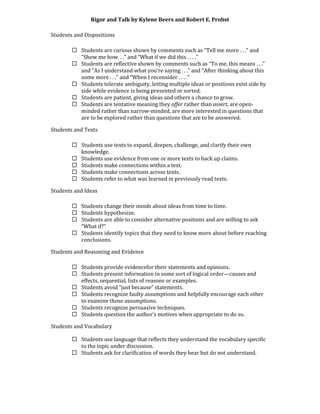
Rigor and Talk by Kylene Beers and Robert E. Probst
- 1. Rigor and Talk by Kylene Beers and Robert E. Probst Students and Dispositions Students are curious shown by comments such as “Tell me more . . .” and “Show me how. . .” and “What if we did this . . . .” Students are reflective shown by comments such as “To me, this means . . .” and “As I understand what you’re saying . . .” and “After thinking about this some more . . .” and “When I reconsider . . . .” Students tolerate ambiguity, letting multiple ideas or positions exist side by side while evidence is being presented or sorted. Students are patient, giving ideas and others a chance to grow. Students are tentative meaning they offer rather than assert, are open- minded rather than narrow-minded, are more interested in questions that are to be explored rather than questions that are to be answered. Students and Texts Students use texts to expand, deepen, challenge, and clarify their own knowledge. Students use evidence from one or more texts to back up claims. Students make connections within a text. Students make connections across texts. Students refer to what was learned in previously read texts. Students and Ideas Students change their minds about ideas from time to time. Students hypothesize. Students are able to consider alternative positions and are willing to ask “What if?” Students identify topics that they need to know more about before reaching conclusions. Students and Reasoning and Evidence Students provide evidencefor their statements and opinions. Students present information in some sort of logical order—causes and effects, sequential, lists of reasons or examples. Students avoid “just because” statements. Students recognize faulty assumptions and helpfully encourage each other to examine those assumptions. Students recognize persuasive techniques. Students question the author’s motives when appropriate to do so. Students and Vocabulary Students use language that reflects they understand the vocabulary specific to the topic under discussion. Students ask for clarification of words they hear but do not understand.
